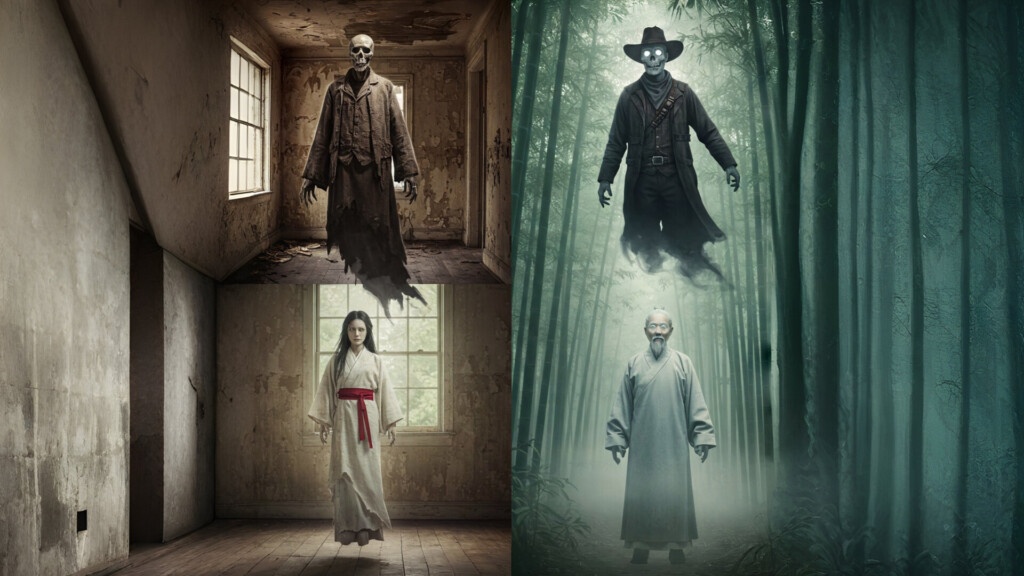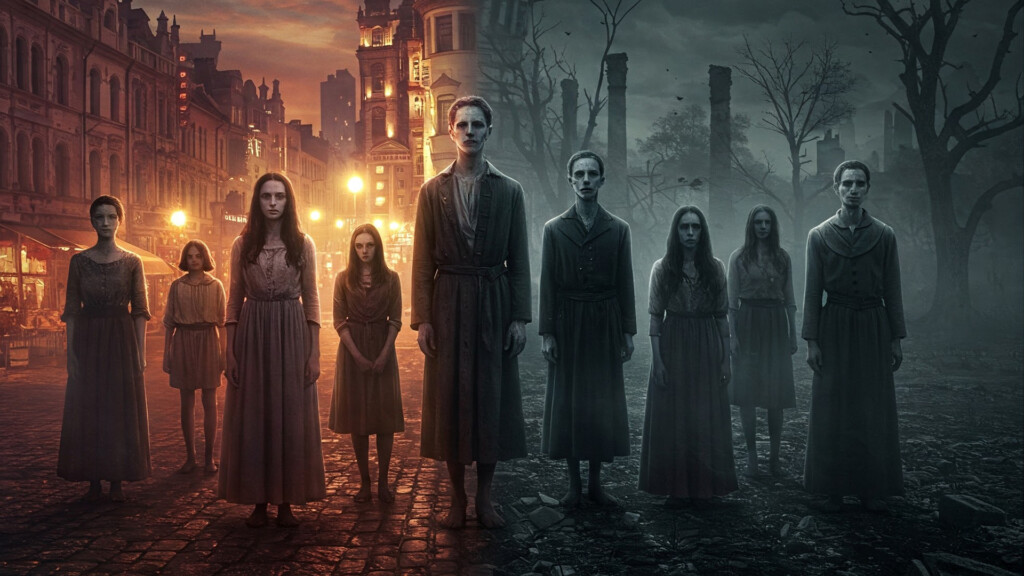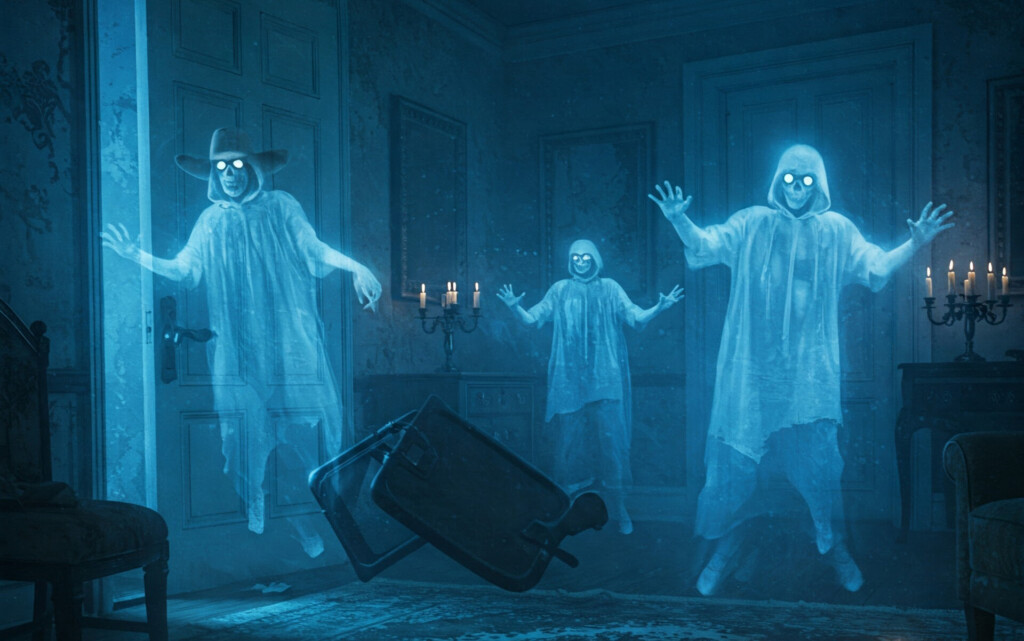Imagine walking into an abandoned house at midnight—what would you encounter? A white figure with long hair floating at the end of the hallway or a chair suddenly moving on its own with a creepy laugh in the background? The answer depends on… where you are!

Western ghosts and Asian ghosts differ not only in appearance but also in their origins, behaviors, and even their preferred methods of haunting. These differences aren’t just about folklore or movies; they reflect deeper cultural beliefs, spiritual traditions, and worldviews. So, why are Western ghosts different from Asian ghosts?
1. The Origin of Ghosts: The Afterlife Explained Differently
👻 Western Ghosts: Lost Souls Between Two Worlds
In Western beliefs, ghosts are often spirits unable to move on due to unfinished business, wrongful death, or being trapped between the world of the living and the afterlife. Many ghost stories in the West are tied to Christianity, where souls may be judged, condemned, or left wandering if they haven’t found peace.

Take Edinburgh Castle (Scotland), for example—its dungeons are said to be haunted by the spirits of tortured prisoners, their eerie moans still echoing in the darkness. This aligns with the Western idea that some souls remain stuck in this world if their deaths were unjust.
👻 Asian Ghosts: Karma, Reincarnation, and Vengeful Spirits
Asian ghost stories, on the other hand, are deeply intertwined with karma and reincarnation. If a person dies suddenly, unjustly, or without proper burial rituals, their spirit may become a ghost, unable to reincarnate. This is why ancestral worship is crucial in many Asian cultures—not just as a sign of respect, but also to prevent the dead from turning into restless spirits.
For instance, the Japanese tale of Okiku, a servant girl killed and thrown into a well, illustrates this belief. Her spirit was said to count plates at night (“one… two… three…”) but never reached ten, symbolizing her unresolved suffering and inability to reincarnate.
2. Ghostly Appearances: Even Ghosts Have a Dress Code!
👀 Western Ghosts: Transparent Figures, Chains, and Eerie Glows
Western ghosts often appear as shadowy figures, translucent shapes, or floating apparitions, sometimes carrying chains (symbolizing their past sins) or wounds from their deaths.
A famous example is the Headless Horseman, a ghostly figure in American folklore. Said to be the spirit of a fallen soldier, he rides at night holding a glowing pumpkin where his head should be, representing eternal unrest and fear.
👀 Asian Ghosts: Long Hair, White Clothes, and Floating Without Legs
While Western ghosts may look vague and shadowy, Asian ghosts tend to be much more terrifying and vividly detailed. They are often described as having long, unkempt hair, pale skin, wearing white robes, and—most notably—lacking feet, symbolizing their detachment from the human world.
Think of Sadako from The Ring, crawling out of the TV screen with her long, wet hair covering her face. This image is deeply rooted in Asian horror traditions, where ghosts are believed to transcend physical limitations when seeking their victims.
3. Haunting Styles: Ghosts Have Different “Work Ethics”
😱 Western Ghosts: Moving Objects and Playing Mind Games
Western ghosts love causing disturbances—they slam doors, make objects float, flicker lights, and sometimes even communicate through Ouija boards.

Take Poltergeist hauntings in the US and UK, where unseen forces move objects, turn lights on and off, and sometimes even push people over. These ghosts are less about direct attacks and more about making their presence known through spooky pranks.
😱 Asian Ghosts: Attaching to People, Possessing Bodies, and Seeking Revenge
Unlike Western ghosts, which tend to haunt places, Asian ghosts often haunt people. They may possess humans (spiritual possession, sleep paralysis) or cause a string of bad luck, illness, or accidents.
A chilling example is the Thai ghost legend of Mae Nak, a woman who died in childbirth but continued to live with her husband. When he discovered the truth, instead of letting go peacefully, she became a relentless nightmare, following him even after death.
4. How to Get Rid of a Ghost: Different Exorcism Techniques
While cultures have different methods of dealing with spirits, one question remains: Are ghosts real? Do these rituals actually banish spirits, or are they simply psychological reassurance for the living?
| Western Methods | Asian Methods |
|---|---|
| Holy water, crucifixes, and exorcism rituals | Burning joss paper, ancestor offerings, and shaman rituals |
| Investigating the cause of death to help the ghost move on | Avoiding haunted places and being respectful to spirits |
| Using salt to ward off evil spirits | Writing protective talismans and sticking them on mirrors or doors |
Can Ghosts Embrace Cultural Exchange?
Whether it’s Western ghosts throwing furniture across the room or Asian ghosts whispering in your ear at night, each type of ghost embodies the cultural fears and beliefs of their region. But have you ever wondered—if the world is becoming more connected, could ghosts start a cultural exchange program too?
Maybe one day, Asian ghosts will start using Ouija boards, and Western ghosts will scan QR codes to “friend” their spectral buddies across continents. Or perhaps they’ll host a “Global Haunting Summit” to discuss new and innovative ways to spook humans just enough to keep things interesting! 😈
